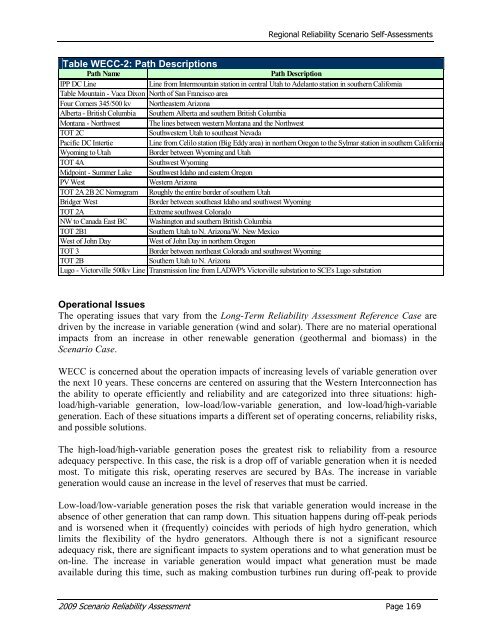2009 Scenario Reliability Assessment - NERC
2009 Scenario Reliability Assessment - NERC
2009 Scenario Reliability Assessment - NERC
- No tags were found...
Create successful ePaper yourself
Turn your PDF publications into a flip-book with our unique Google optimized e-Paper software.
Regional <strong>Reliability</strong> <strong>Scenario</strong> Self-<strong>Assessment</strong>sTable WECC-2: Path DescriptionsPath NamePath DescriptionIPP DC LineLine from Intermountain station in central Utah to Adelanto station in southern CaliforniaTable Mountain - Vaca Dixon North of San Francisco areaFour Corners 345/500 kv Northeastern ArizonaAlberta - British Columbia Southern Alberta and southern British ColumbiaMontana - Northwest The lines between western Montana and the NorthwestTOT 2CSouthwestern Utah to southeast NevadaPacific DC Intertie Line from Celilo station (Big Eddy area) in northern Oregon to the Sylmar station in southern CaliforniaWyoming to Utah Border between Wyoming and UtahTOT 4ASouthwest WyomingMidpoint - Summer Lake Southwest Idaho and eastern OregonPV WestWestern ArizonaTOT 2A 2B 2C Nomogram Roughly the entire border of southern UtahBridger WestBorder between southeast Idaho and southwest WyomingTOT 2AExtreme southwest ColoradoNW to Canada East BC Washington and southern British ColumbiaTOT 2B1Southern Utah to N. Arizona/W. New MexicoWest of John Day West of John Day in northern OregonTOT 3Border between northeast Colorado and southwest WyomingTOT 2BSouthern Utah to N. ArizonaLugo - Victorville 500kv Line Transmission line from LADWP's Victorville substation to SCE's Lugo substationOperational IssuesThe operating issues that vary from the Long-Term <strong>Reliability</strong> <strong>Assessment</strong> Reference Case aredriven by the increase in variable generation (wind and solar). There are no material operationalimpacts from an increase in other renewable generation (geothermal and biomass) in the<strong>Scenario</strong> Case.WECC is concerned about the operation impacts of increasing levels of variable generation overthe next 10 years. These concerns are centered on assuring that the Western Interconnection hasthe ability to operate efficiently and reliability and are categorized into three situations: highload/high-variablegeneration, low-load/low-variable generation, and low-load/high-variablegeneration. Each of these situations imparts a different set of operating concerns, reliability risks,and possible solutions.The high-load/high-variable generation poses the greatest risk to reliability from a resourceadequacy perspective. In this case, the risk is a drop off of variable generation when it is neededmost. To mitigate this risk, operating reserves are secured by BAs. The increase in variablegeneration would cause an increase in the level of reserves that must be carried.Low-load/low-variable generation poses the risk that variable generation would increase in theabsence of other generation that can ramp down. This situation happens during off-peak periodsand is worsened when it (frequently) coincides with periods of high hydro generation, whichlimits the flexibility of the hydro generators. Although there is not a significant resourceadequacy risk, there are significant impacts to system operations and to what generation must beon-line. The increase in variable generation would impact what generation must be madeavailable during this time, such as making combustion turbines run during off-peak to provide<strong>2009</strong> <strong>Scenario</strong> <strong>Reliability</strong> <strong>Assessment</strong> Page 169
















